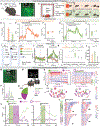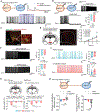GLP-1 increases preingestive satiation via hypothalamic circuits in mice and humans
- PMID: 38935778
- PMCID: PMC11961025
- DOI: 10.1126/science.adj2537
GLP-1 increases preingestive satiation via hypothalamic circuits in mice and humans
Abstract
Glucagon-like peptide-1 (GLP-1) receptor agonists (GLP-1RAs) are effective antiobesity drugs. However, the precise central mechanisms of GLP-1RAs remain elusive. We administered GLP-1RAs to patients with obesity and observed a heightened sense of preingestive satiation. Analysis of human and mouse brain samples pinpointed GLP-1 receptor (GLP-1R) neurons in the dorsomedial hypothalamus (DMH) as candidates for encoding preingestive satiation. Optogenetic manipulation of DMHGLP-1R neurons caused satiation. Calcium imaging demonstrated that these neurons are actively involved in encoding preingestive satiation. GLP-1RA administration increased the activity of DMHGLP-1R neurons selectively during eating behavior. We further identified that an intricate interplay between DMHGLP-1R neurons and neuropeptide Y/agouti-related peptide neurons of the arcuate nucleus (ARCNPY/AgRP neurons) occurs to regulate food intake. Our findings reveal a hypothalamic mechanism through which GLP-1RAs control preingestive satiation, offering previously unexplored neural targets for obesity and metabolic diseases.
Conflict of interest statement
Figures





References
Publication types
MeSH terms
Substances
Grants and funding
LinkOut - more resources
Full Text Sources
Other Literature Sources
Medical
Molecular Biology Databases
Miscellaneous

